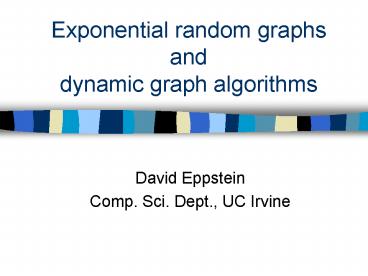Exponential random graphs and dynamic graph algorithms - PowerPoint PPT Presentation
Title:
Exponential random graphs and dynamic graph algorithms
Description:
Exponential random graphs and dynamic graph algorithms David Eppstein Comp. Sci. Dept., UC Irvine – PowerPoint PPT presentation
Number of Views:71
Avg rating:3.0/5.0
Title: Exponential random graphs and dynamic graph algorithms
1
Exponential random graphsanddynamic graph
algorithms
- David Eppstein
- Comp. Sci. Dept., UC Irvine
2
What are we trying to do?
- Probabilistic reasoning on social networks
- Appropriately model the different likelihoods of
finding different types of network
3
Exponential Random Graphs
- Family of graphs with fixed vertex set
- Probability of a graph is proportional to exp(sum
of weights of features) - Different choices of features give simpler or
more powerful models
4
ERG models can be simple
- Easily subsumes many standard random graph models
- E.g. G(n,p)
- Edges are independent w/probability p
- Feature edge
- Weight log(p) - log(1-p)
5
but ERG models can also be very powerful
- Powerful enough to represent any distribution
over n-vertex graphs - Feature isomorphism with one graph
- Weight log(probability of that graph)
- More power requires a more complex set of features
6
Computational tasks for reasoning with ERGs
- Compute normalizing factor (partition function)
for graph probabilities - Generate random graphs from the model
- Use the model as a prior for max-likelihood data
fitting, or modify the feature weights to fit the
data
7
Monte Carlo methods for computing with ERGs
- Start with an arbitrary graph
- Repeatedly propose a small change (e.g., insert
or delete a single edge) - Compute log-likelihood of the modified graph and
use it to accept or reject the proposed change
8
The Algorithmic Lens
- Social scientists and statisticians determine the
sorts of models that best describe their data - Algorithms researchers (e.g. me) figure out how
to make the model run quickly - Faster algorithms lead to the ability to use more
accurate models
9
Algorithmic rephrasing of the computational task
- Maintain a dynamic graph subject to edge
insertions and deletions - As the graph changes, keep track of its
computational properties efficiently (faster than
recomputing them from scratch) - The properties we track should be the ones needed
for ERG feature vectors
10
A brief survey of dynamic graph algorithms
- Sparsification (E., Galil, Italiano, Nissenzweig,
JACM 92) - Replace dense graphs by tree of sparse subgraphs
- Applies to many problems including maintaining
connected components - Replaces edges by vertices in running times of
update algorithms
11
A brief survey of dynamic graph algorithms
- Fast dynamic connectivity (Holm, de Lichtenberg,
Thorup, JACM 2001) - Maintain connected components, number of
connected components, or a spanning tree (so can
use components as ERG feature) - Update time O(log n log log n)
- Complicated, of interest to search for more
easily implemented variants
12
A brief survey of dynamic graph algorithms
- Distance and reachability in graphs
- Of likely use in ERGs (e.g. to model small-world
properties of these graphs) - Some dynamic graph algorithms are known but more
theoretical than practical
13
A brief survey of dynamic graph algorithms
- Graphs in the plane and on surfaces
- E. et al, J. Algorithms 1992
- E. et al, J. Comp. Sys. Sci. 1996
- E., SODA 2002
- Of possible interest for integrating social
networks with geographic data
14
Not-yet-dynamized graph algorithms useful for ERGs
- Low-degree orientations of sparse graphs
(Chrobak, E., Theor. Comp. Sci. 1991) - Assign directions to the edges of the graph so
that each vertex has O(1) outgoing edges - Enable fast search for small subgraphs (e.g. list
all cliques in linear time) - May be found in linear time
15
Not-yet-dynamized graph algorithms useful for ERGs
- Finding all maximal complete bipartite subgraphs
in a sparse graph (E., IPL 1994) - Allows concise representation of all four-vertex
cycles (quadratically many cycles may be
represented in linear space and time) - Based on low-degree orientation
16
Not-yet-dynamized graph algorithms useful for ERGs
- Subgraph isomorphism finding all copies of some
small pattern graph in a larger graph (E., J.
Graph Th. 1993 and J. Graph Algorithms 1999) - Commonly used as ERG features
- Known fast algorithms rely on special graph
properties e.g. planarity
17
Conclusions
- ERG are important model for social nets
- ERG computation naturally involves dynamic graphs
- Many existing dynamic graph algorithms known, not
fully adapted to ERG problems - Much opportunity for further study of dynamic
graph algorithms in ERG setting

